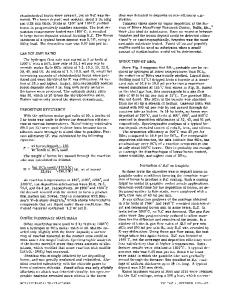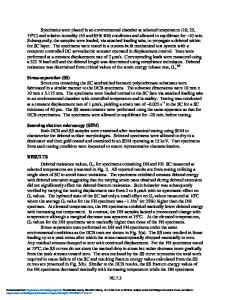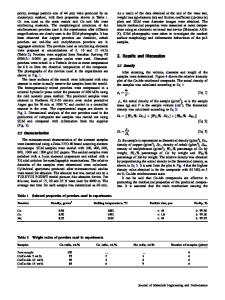Microstructural and Mechanical Properties of Boron Carbide Ceramics by Methanol Washed Powder
- PDF / 375,699 Bytes
- 4 Pages / 595 x 842 pts (A4) Page_size
- 30 Downloads / 271 Views
1224-FF10-35
Microstructural and Mechanical Properties of Boron Carbide Ceramics by Methanol Washed Powder Jong Pil Ahn1,2 , Kyoung Hun Kim1, Joo Seok Park1 , Jae Hong Chae1 , Sung Min So1,2 and Hyung Sun Kim2 1 Korea Institute of Ceramic Engineering and Technology, 233-5, Gasan-Dong, GuemcheonGu, Seoul, 153-801, Korea 2 Information Materials Lab. Materials Engineering, Inha University. 253, Yonghyun-dong, Nam-gu, Incheon, 402-751, Korea ABSTRACT B4C ceramics were fabricated by a hot-press sintering and its sintering behavior, microstructure and mechanical properties were evaluated. The relative density of B4C ceramics were obtained by a hot-press sintering reached as high as 99% without any sintering additives. The mechanical properties of B4C ceramics was improved by a methanol washing which can remove B2O3 phase from a B4C powder surface. This improvement is resulted from the formation of homogeneous microstructure because the grain coarsening was suppressed by the elimination of B2O3 phase. Particularly, the mechanical properties of the sintered samples using a methanol washed powder improved compared with the samples using an asreceived commercial powder. INTRODUCTION Boron carbide (B4C) is very useful ceramics in engineering applications because of its excellent mechanical properties. B4C is premier material for personal ballistic armor because it is the third hardest material behind diamond and cubic boron nitride (c-BN), in addition to its low theoretical density (2.52 g/cm3) [1]. B4C is also used as abrasive applications such as abrasive powder and nozzles due to its excellent abrasion and wear resistance [2]. It has been reported that the mechanical properties of B4C ceramics depend on the B/C ratio because Boron Carbide exists as a solid solution in the range of 8.8 to 20 at% carbon (B10.5C – B4C) [3 - 5]. It was reported that the hardness and fracture toughness values were maximum at essentially the stoichiometric composition B/C = 4 and decreased for B/C < 4 (composition region of B4C + C) and for B/C > 4 (non-stoichiometric region of B4C) [5]. The B4C has low specific gravity and mechanical properties to use lightweight armor and the high temperature material. Densification of B4C is difficult, because of high covalent bonding and boron oxide (B2O3) film on B4C particles surface which can cause a microstructural coarsening during sintering. Sintering behavior, microstructure and mechanical properties of hot press sintered B4C were evaluated. EXPERIMENTAL DETAILS Commercially available B4C powder (HS grade, H.C. Starck, Germany) was used as a starting material. The commercial B4C powder was suspended in methanol (99.9%, J.T. Baker, USA) and ultrasonicated (B3200, Branson, USA) for 1 hour. The suspension was then placed in dry oven at 80℃ for 12 hours to volatilize methanol. This process was repeated three times for the purpose of removing B2O3 coatings from the surface [6]. The powders were loaded into a graphite mold and then Hot press sintering(MHP-350, Mono Cerapia, Korea) at temperature range from
Data Loading...









